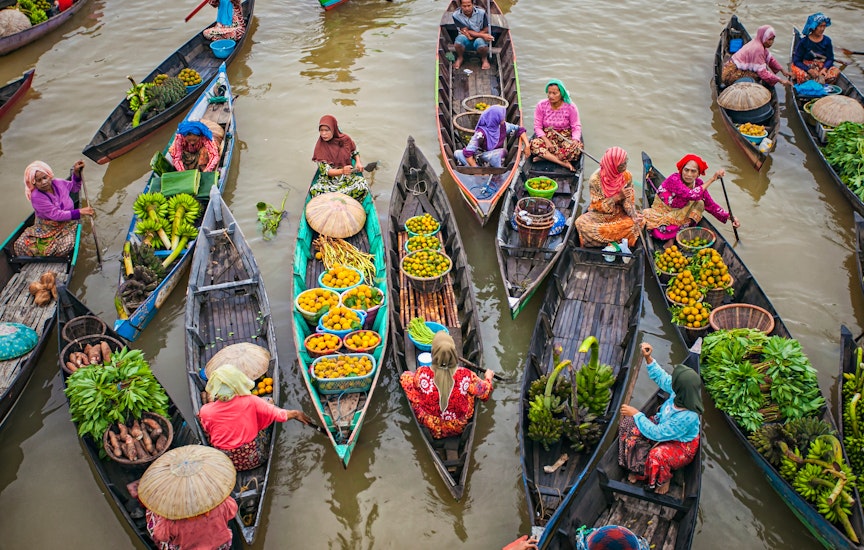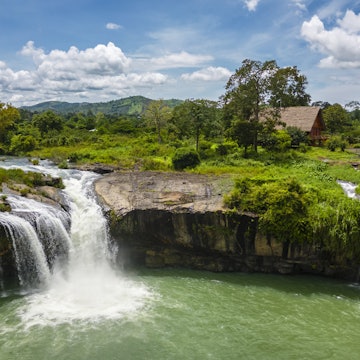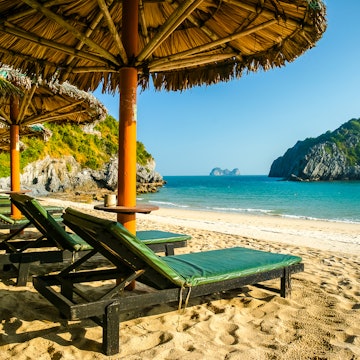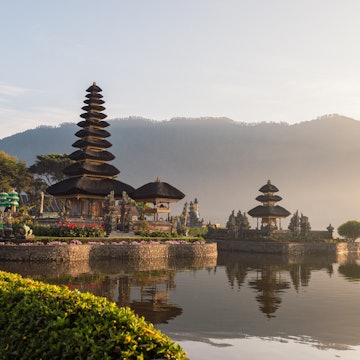
Take in the highlights of Sulawesi, Indonesia, on this 9-day itinerary


Traditional tongkonan houses in Tana Toraja on Sulawesi, Indonesia. Larisa Dmitrieva/Shutterstock
The island of Sulawesi offers plenty of surprises. Many travelers are drawn to this dramatic corner of eastern Indonesia by the fascinating highland culture of Tana Toraja, the remote Togean Islands or the spectacular diving around Pulau Bunaken and the Lembeh Strait. Yet there’s much more to see in Sulawesi for those willing to endure the sometimes slow and inconvenient transport links on the island.
Flanked by teeming waters and reefs, Sulawesi’s interior is mountainous and cloaked in dense jungle. Here, iconic species such as nocturnal tarsiers, knobbed hornbills and flamboyant maleo birds thrive – as do proud cultures, long isolated by impenetrable topography. There are scenic coastlines to explore, too, from remote islands to the beaches of the Bira peninsula.
Traces of history abound. In addition to the island’s rich Indigenous heritage, the Dutch made Sulawesi a focal point of their domination of the 17th-century spice trade, governing from their fort in Makassar (Ujung Padang) until the Japanese occupation began in 1942.
Part of Indonesia since 1950, this is one of the most intriguing corners of this vast archipelago for travelers. Discover the highlights on this 9-day Sulawesi itinerary.
When to arrive in Sulawesi
Travelers flock to Sulawesi during the dry season, from April to October, and this is the best time for scuba diving, hiking and festivals. June to August is the peak season for traditional funeral ceremonies in Tana Toraja, while both the Toraja Coffee Festival and the Tomohon International Flower Festival take place in August. Keep in mind that coming in peak season means higher prices and more competition for hotel rooms and plane seats.
The wet season, from November to March, is the low season for tourism – bringing both lower prices and rougher sea conditions for travel to islands offshore. The cultural calendar is a little quieter during the rainy months, though Christmas is celebrated enthusiastically by Christian communities in regions such as North Sulawesi and Tana Toraja.

How to get around in Sulawesi
Makassar’s Sultan Hasanuddin International Airport is a busy hub, with regular flights from destinations across Indonesia and Southeast Asia, including easy connections from Jakarta and Bali. On arrival in Makassar, you can reach the city center by bus or prepaid taxi. Small planes buzz out to small airstrips across Sulawesi, including Manado, which has flights on to destinations across Asia.
To reach other parts of Sulawesi, you can fly to save time – though you’ll see more of the lush countryside when you travel by bus or shared taxi. Luxury air-conditioned coaches connect Makassar with Rantepao in Tana Toraja. Local buses, long-distance bemo (minibuses), and shared or chartered taxis will get you to other destinations in Sulawesi. Boats also run between Sulawesi’s many peninsulas and to outlying islands, though not always daily.
If you have the funds, chartering a vehicle and driver is perhaps the most relaxing way to travel. Trains run from Makassar as far as Parepare, but it will be some years before the planned service to Manado is operational.
What to pack for Sulawesi
Sulawesi is quite a traditional part of Indonesia, so follow the lead of locals when it comes to dress. Pack lots of lightweight, breathable cotton clothing that covers the upper arms and upper legs, and keep a sarong handy for entering mosques and other sacred sites. Bring comfortable shoes you can hike in, as well as flip flops or sandals.
As well as beachwear, you’ll want to pack some warmer layers – such as a fleece top or a hoodie – for cooler temperatures at night in the highlands, as well as for the frosty air-conditioning on public transport. A raincoat or umbrella can come in handy at any time of year. Other essentials include a sun hat and sunscreen and plenty of mosquito repellent, plus a plug-in mosquito killer or mosquito net.

Days 1–2: Soak up Makassar’s big-city energy
How to spend the days: Start your trip to Sulawesi by exploring Makassar, the island’s proud and vibrant capital. The dazzling 99-dome Asmaul Husnah 99 Kubah mosque gives the waterfront a strong visual appeal, as does Dutch-built Fort Rotterdam, today housing the interesting Museum Negeri La Galigo. If you visit the mosque, you’ll cross a cable bridge shaped like a tongkonan (traditional Torajan house).
Gritty but energetic, Makassar is one of Indonesia’s primary ports, with a polyglot population of Makassarese, Bugis and Chinese residents. While there are few major sights, you can pass a rewarding day or two exploring the waterfront and pinisi (schooner) harbor, and dropping into the city’s celebrated seafood restaurants and state-of-the-art shopping malls.
Take some time to wander the walls of Fort Rotterdam, one of the best-preserved examples of Dutch military architecture in all of Indonesia. Walk along the enclave’s stout ramparts, then head further south along the Pantai Losari promenade. Another worthy detour is the Pelabuhan Paotere boat harbor, 4km north of the city center, where photogenic sailing ships berth and fishermen land their catches.
To stay cool, hit Makassar’s air-conditioned shopping malls. At the top of the list for family fun is Trans Studio Mall, a giant indoor theme park and temple to shopping, with an indoor artificial snow zone. Nearby, and just south of the Center Point monument, Phinisi Point offers more shopping and family fun.
Evenings: With two evenings to fill, you can dive headlong into the Makassar dining scene. Close to Pantai Losari, Sentosa is a popular noodle soup and bakso (meatball soup) joint, while RM Nelayan serves fish grilled on fragrant charcoal braziers. Around Fort Rotterdam, Coto Nusantara is a hit for coto Makassar (spicy peanut and beef soup), while local warungs (casual food stands) serve tasty fresh seafood.
Alternatively, join the locals who dine away from the waterfront. North of the fort, Rumah Makan Pate’ne serves quality Makassarese and Indonesian classics at budget prices, while renowned seafood restaurant Lae Lae serves no-frills grilled fish dishes near the south end of Pantai Losari.

Day 3: Take in the karst scenery of Rammang Rammang
Go to Rammang Rammang: You can cover the 45km between Makassar and Rammang Rammang in around an hour by pete-pete (local minibus) or chartered taxi.
How to spend the day: Rammang Rammang’s karst mountains make for an unmissable and photogenic day trip from the city. The adventure begins near the village of Salenrang, where multicolored wooden boats that look like tropical gondolas wait for passengers.
Boat tours motor along a mangrove-lined river to the village of Berua, enclosed by a bowl of spectacular karst buttresses. A 3km-long looping boardwalk trail will take you past disused fish farms, gua (caves) and impressive viewpoints. The village has two friendly but basic homestays if you’re inspired to stop overnight; you can also stay at Rammang Rammang Eco Lodge on the river.
If you’re visiting in the late afternoon, ask your guide or boat driver about the bat caves. Around sunset, thousands of bats pour out from caves in the karst cliffs to start their nightly feeding, running a gauntlet of eagles looking for a bite of their own.
Consider adding a detour to the caves of Leang Leang Archaeological Park near Maros. The caverns are noteworthy for their ancient cave paintings and handprints. Recent studies have placed the art at over 40,000 years old, making these the oldest pictographs in the world!
Evening: In Rammang Rammang, you can eat at your homestay or the inviting cafe at the Rammang Rammang Eco Lodge. If you return to Makassar, head over to Gravity Sky Lounge for live music, good bar food and gorgeous views from the 20th floor of the Swiss-Belhotel.

Days 4–5: Dive into the underwater world at Bira
Go to Bira: The scenic, beach-hemmed Bira peninsula sits at the southernmost point of mainland Sulawesi, about five hours from Makassar by local bus or minibus. Consider taking an overnight bus to Bira, which would give you a full day and night before heading back to Makassar the day after.
How to spend the days: Use your time here to enjoy a string of sandy beaches and some of the best scuba diving and snorkeling in South Sulawesi. Sand lovers gravitate toward Pantai Bira, the main village beach, and quieter, prettier Pantai Bara, a crescent of white sand fringed by low cliffs and palms.
There’s plenty to do here, even if you don’t get into the water. Take a short boat ride to the nearby island of Pulau Liukang Loe to see locals making silk sarongs, watch skilled carpenters building huge pinisi boats right on the beach, or savor the sunrise and sunset from the windswept lookout jutting into the Flores Sea.
If you’re keen to dip into the marine world, Pulau Liukang Loe is a popular destination for snorkeling trips, with a shallow reef stretching for around 1km to Shark Point. For divers, Bira is famous as one of the “sharkiest” locations in Indonesia, particularly around the island of Pulau Kambing. Make arrangements a day ahead with a local dive operator, such as Blue Planet.
The Great Wall of Goat on Kambing’s eastern side has a remarkable vertical face teeming with reef life, including hammerheads, thresher sharks and manta and devil rays. To surround yourself with a kaleidoscope of reef fish, take a dive at the remarkable Fish Market. Mola-Mola Point is the place to see giant sunfish, while Shark Point attracts turtles and sea snakes, as well as numerous species of sharks.
Evening: There’s good eating at resort restaurants in Bira. Vegetarians will enjoy the Malaysian and Indian flavors at Tevana House Reef, while the clifftop restaurant at Akasha Beach Club combines Asian and Western dishes with great views. Enjoy more dining with a view at Seascapes by Pantai Bara.

Days 5–6: Discover island culture in Tana Toraja
Go to Rantepao: You’ll have to make your way back to Makassar to pick up the luxury air-conditioned overnight coach service to Rantepao, the gateway to the Tana Toraja region. Book transport a day or two ahead.
How to spend the days: The people of Tana Toraja form a distinct ethnic group, with one of the most recognizable and compelling traditional cultures in Indonesia. You’ll want to spend at least two days exploring this spectacular region, with its cascading rice fields, spooky tau tau (carved wooden figures), cave tombs, hanging graves and soaring tongkonan houses.
Rantepao is the best base for making forays into the hills by motorcycle, local minibus or chartered vehicle, and it has a wide range of accommodation, restaurants, markets and guides. Agreeably, the town quickly morphs into fields on the outskirts, and you’re never far from the crow of a rooster. Climb the hill of Buntu Singki (930m) just west of the river for panoramic views across Rantepao and the surrounding countryside.
About 2km north of town near the bus stand, Pasar Bolu is a large covered market where Torajans come to buy and sell daily. Just south is the area’s famous water buffalo market, Pasar Hewan. Every six days, water buffalo are brought in from all over Sulawesi to be traded, with many to be used in traditional funeral sacrifices.
Arrange a tour to local villages or detour off the main road south of Rantepao by rented car or motorbike. The hilltop village of Buntu Pune has two fine tongkonan houses and four rice barns, while nearby Ke’te Kesu’ has four stately tongkonan and many traditional granaries, cave tombs and hanging coffins.

Backtrack to reach Londa, one of Toraja’s most dramatic burial caves. A lantern-wielding guide will lead you past a balcony of carved wooden tau tau figurines to view the bone-filled chambers inside. About 4.5km further south, Lemo is alive with tau tau; they stare down with unblinking eyes and outstretched arms from a burial cliff riddled with tombs.
North of Rantepao, villages full of traditional tongkonan appear around every turn. One of the most popular is Batutumonga, accessible on a looping drive from Rantepao. En route, you can visit the weaving village of Sangkombong, the standing funerary stones at Bori' Kalimbuang, and the rock tombs of Lo’ko’ Mata.
Local guides can arrange visits to observe traditional Torajan funerals, which mostly take place in July and August. These lavish affairs often occur long after the point of death, with the deceased remaining in the family home until the ceremony is conducted. The final funeral is marked by dancing, special foods, and the ritual sacrifice of buffalo – a gruesome spectacle that some travelers may prefer to avoid.
Evening: Rantepao has plenty of good places to eat. On the main drag, Rumah Makan Saruran serves oodles of fried noodles and other Indonesian-Chinese dishes, while Rimiko Restoran is good for Torajan specialties such as buffalo, pork and eel in black sauce. For a posh dinner, head to the restaurant at boutique hotel Santai Toraja at the south end of town.

Days 7–10: End the trip on the Togean Islands
Go to the Togean Islands: Reaching the Togean Islands from Rantepao involves a full day of travel by bus, bemo or car to Tentena, where you might want to pause to view the monoliths of the Bada Valley. It’s then a four-hour journey to Ampana, where boats leave for Wakai and Bomba on Pulau Batu Daka.
How to spend the days: On arrival in the Togean Islands, you’ll find a true castaway paradise. The islands have no wi-fi or phone reception and no cars, and electricity is limited to generators. Yet deserted golden beaches abound and hammocks dangle enticingly from the porches of seafront bungalows facing the surf.
The villages of Wakai and Bomba are the most popular bases for exploring; there are also quality resorts on Pulau Kadidiri. Scuba diving and snorkeling trips visit reefs around Pulau Batu Daka and other islands in the archipelago, such as tiny Kadidiri, volcano-topped Pulau Una Una and mangrove- and reef-rimmed Pulau Togean.
Below the surface, drop-offs feature giant gorgonian fans, and reefs throng with tropical fish and macro life, including seahorses, painted frogfishes and leaf scorpion fishes. You can also dive to see a well-preserved sunken WWII B-24 bomber plane, and swim with stingless jellyfish at Danau Mariona (better known as Jellyfish Lake), halfway between Kadidiri and Katupat.
When it’s time to exit this gorgeous getaway, you can retrace your steps to Ampana and fly back to Makassar via Palu in the center of Sulawesi. Alternatively, there’s a twice-weekly overnight ferry from Wakai to Gorontalo, where you can swim with whale sharks before exiting Sulawesi at Manado in the far north (perhaps with a diving detour to Pulau Bunaken).
Evening: Most people eat where they stay in the Togean Islands, but some resorts welcome non-guests. Bomba and Wakai have a smattering of other places for a bite.
This article was adapted from Lonely Planet’s Indonesia guidebook, published in July 2024.















